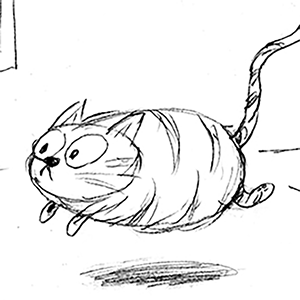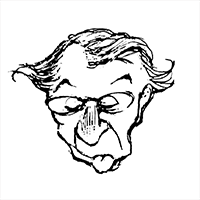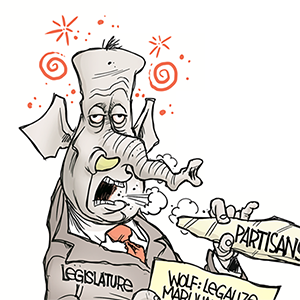Politics
/ArcaMax

California vs. Trump: What it's like to be the attorneys on the front lines
LOS ANGELES -- Michael Newman, head of the civil rights enforcement section in California Attorney General Rob Bonta’s office, was exhausted.
Newman and his legal team had just worked all weekend, straight through that Monday and overnight into Tuesday on a growing pile of legal challenges to the Trump administration, and were overdue for ...Read more

Trump's Smithsonian order follows Reconstruction playbook in rewriting history
Margaret Mitchell was born in 1900, a quarter century after the beginning and subsequently abrupt end of Reconstruction.
She was a privileged daughter in a wealthy and politically prominent Atlanta family at the height of The Lost Cause myth, which argued that the South’s involvement in the Civil War was about states’ rights and heroism, ...Read more

Trump team rejects market fears, shows defiance on tariffs
President Donald Trump’s top economic officials dismissed investors’ fears of inflation and recession, offering no apologies for the market turmoil sparked by sweeping global tariffs and defiantly insisting a boom is on the horizon.
On the heels of huge global stock market falls, Treasury Secretary Scott Bessent, Commerce Secretary Howard ...Read more

Trump team rejects market fears, shows defiance on tariffs
President Donald Trump’s top economic officials dismissed investors’ fears of inflation and recession, offering no apologies for the market turmoil sparked by sweeping global tariffs and defiantly insisting a boom is on the horizon.
On the heels of huge global stock market falls, Treasury Secretary Scott Bessent, Commerce Secretary Howard ...Read more

Vietnam offers to remove tariffs on US after Trump's action
Vietnam offered to remove all tariffs on US imports after President Donald Trump announced a 46% levy on the Southeast Asian nation, according to an April 5 letter from Vietnam’s communist party.
The offer was made by party chief To Lam to Trump in a letter seen by Bloomberg. Lam requested that the U.S. not apply any additional tariffs or ...Read more

Can Sen. Adam Schiff protect California farms, workers from Trump tariffs? That's his plan
Sen. Adam Schiff, one of President Donald Trump’s toughest political opponents, is gearing up for another battle in Washington, D.C. — this time in support of California farmers.
In an interview with The Fresno Bee, Schiff spoke in defense of the state’s multibillion-dollar farming industry and the thousands of workers who harvest nearly ...Read more

PM Starmer vows steps to bolster UK against Trump tariff threat
UK Prime Minister Keir Starmer said he’ll announce measures this week to support Britain’s economy and businesses amid the threat posed by Donald Trump’s tariffs.
Writing in the Telegraph, Starmer said, “The world as we knew it has gone. We must rise to meet the moment.”
The U.S. president last week announced sweeping global tariffs...Read more

Bessent defiant on tariffs as he rejects a US recession
U.S. Treasury Secretary Scott Bessent on Sunday struck a defiant tone in the face of global financial markets selling off sharply in response to new U.S. tariffs, arguing the duties were necessary and rejecting the idea that they would cause a U.S. recession.
“I see no reason that we have to price in a recession,” Bessent told NBC’s "...Read more

Big law must stop caving to Trump's demands
Big law firms that have offended President Donald Trump for representing a cause or client he doesn’t like are being forced to make a choice: Either cut a deal with him to protect their billion-dollar businesses, or sue him to assert their right to continue representing clients as they please.
It was extremely disappointing when Paul, Weiss, ...Read more

China pledges resolute measures to hit back at Trump tariffs
China pledged decisive action to defend its economy, a day after unveiling levies on American goods and export controls on rare earths in response to Donald Trump’s tariffs.
Beijing will continue to take “resolute measures” to safeguard its sovereignty, security and other interests, the state-owned Xinhua News Agency reported on Saturday....Read more

Collectors feel relief as classic cars evade Trump's auto tariffs
President Donald Trump’s sweeping tariff plan has rocked global markets, with every single sector in the S&P 500 ending Friday in deep red. But one turgid addendum issued by U.S. Customs and Border Protection just after his April 2 tariff pronouncement provided relief for those in the collectible car business: Vintage cars would be exempt.
...Read more

Musk hopes US, Europe move to zero-tariff free-trade zone
Elon Musk hopes for a “zero-tariff” system between the U.S. and Europe that would effectively create “a free-trade zone,” he said on Saturday, days after levies set by U.S. President Donald Trump sent global markets into a tailspin.
“Both Europe and the United States should move, ideally, in my view, to a zero-tariff situation, ...Read more

Anti-Trump, Musk protests kick off around the nation
LOS ANGELES — Tens of thousands of people took to the streets across the country on Saturday to protest President Donald Trump and a wide range of his administration’s actions, including government downsizing, attacks on the rights of immigrants and transgender people, and tariffs that are roiling economies across the globe.
More than 500,...Read more

Wall Street gets rude shock as Bessent plays second fiddle on tariffs
WASHINGTON — From the moment President Donald Trump unveiled his sweeping tariffs Wednesday through the ensuing market mayhem the following day, Treasury Secretary Scott Bessent’s phone lit up with text messages from executives tied to his former industry.
Multiple hedge fund managers and finance executives reached out, seeking his help in ...Read more

Anti-Trump, Musk protests kick off around the nation
LOS ANGELES — Tens of thousands of people took to the streets across the country on Saturday to protest President Trump and a wide range of his administration’s actions, including government downsizing, attacks on the rights of immigrants and transgender people, and tariffs that are roiling economies across the globe.
More than 500,000 ...Read more

Trump tax cut, debt limit plan advances amid tariff turmoil
Senate Republicans took a major step toward enacting President Donald Trump’s tax cut agenda and increasing the U.S. debt ceiling, potentially injecting a small degree of certainty into financial markets roiled by the president’s tariff policies.
The Senate early Saturday morning passed the budget resolution by a 51-48 margin after an ...Read more

Trump promised a manufacturing boom. Industries are not so sure
President Donald Trump has vowed his historic tariff blitz would revive domestic manufacturing, but industry worries about his approach are raising fresh doubts about whether he can deliver on his promise of an economic boom.
In the Rose Garden on Wednesday, Trump declared “jobs and factories will come roaring back into our country” and ...Read more

Trump tax cut, debt limit plan advances amid tariff turmoil
Senate Republicans took a major step toward enacting President Donald Trump’s tax cut agenda and increasing the U.S. debt ceiling, potentially injecting a small degree of certainty into financial markets roiled by the president’s tariff policies.
The Senate early Saturday morning passed the budget resolution by a 51-48 margin after an ...Read more

'Nowhere to hide.' How Apple and others in Silicon Valley are bracing for Trump tariffs
SAN FRANCISCO — The iPhone is a quintessentially 21st century product — Californian in its creation and design and now enmeshed in the global economy.
Apple makes most of its iPhones in China, though in recent years the Cupertino-based company has made more of its products in India, Vietnam and other nations. In all, the tech giant says it...Read more

Commentary: President Donald Trump's tariffs will cost us
As President Donald Trump laid out his case for sweeping new tariffs, it sounded reasonable. He was only imposing on other countries the burden they impose on us. Those tariffs, he said, would boost our national revenue and decrease our deficit. He recalled a wealthy America 150 years ago funded entirely by tariffs instead of a pesky income tax,...Read more


























































